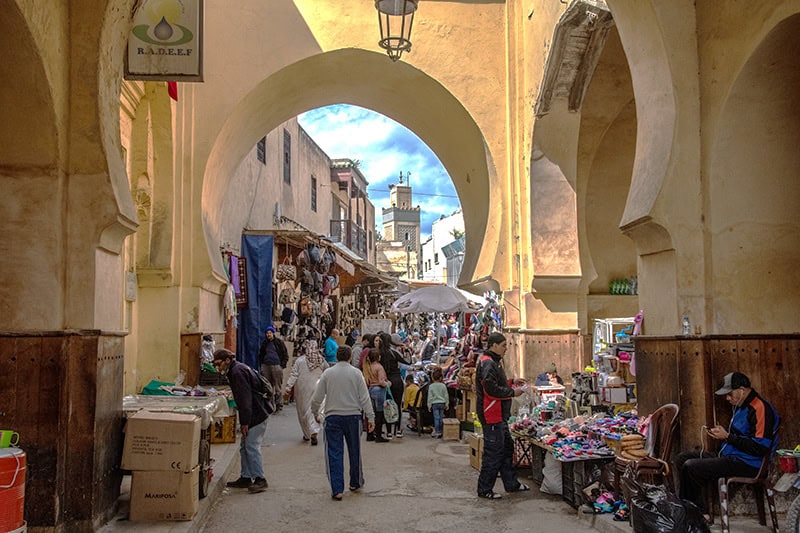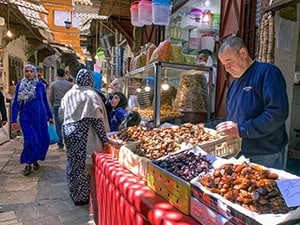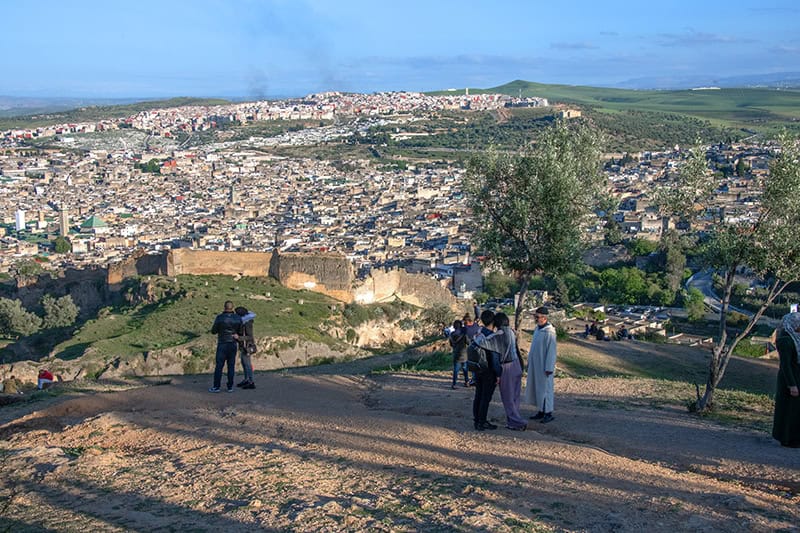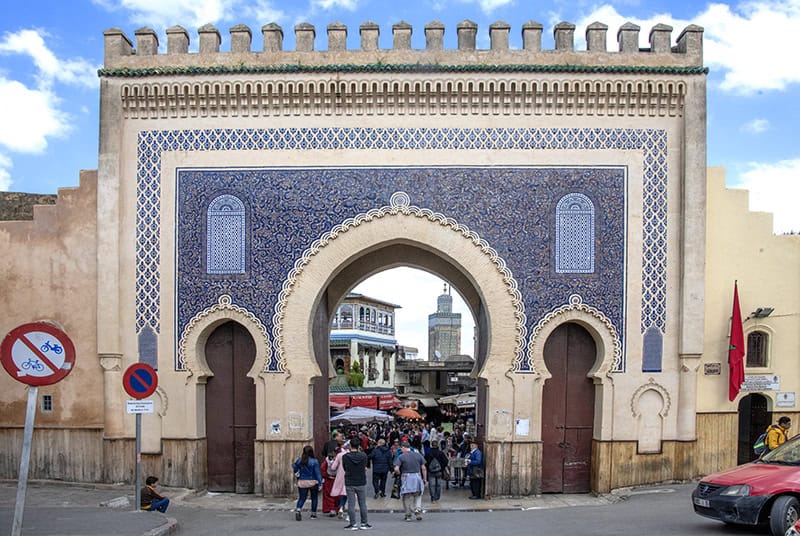Last Updated on July 16, 2024

Estimated reading time: 12 minutes
By Jim Ferri
For millennia, Fez was famous as Morocco’s ancient seat of learning. As the country’s intellectual, cultural, and spiritual center, travelers were told to visit the city to understand Morocco.

But today’s travelers are different from those who arrived on the city’s doorstep a few decades ago. Many now target Fez not for the cultural and spiritual but for the city’s wonderful artistic and culinary treasures. And this city, once considered a place only for a quick stopover, is now becoming a destination in its own right.
In fact, today’s travelers are finding Fez (or Fes; both are correct) so enchanting and exciting that the city is now replacing Marrakesh as Morocco’s most exotic destination.
Air connections from Europe have helped, as have its accessibility from other Moroccan cities. Fez is only 240 miles northeast of Marrakesh and about a 3½ drive from Casablanca. It’s relatively easy to reach if you’re touring different areas of the country (which is highly recommended).
Table of contents

The Surprises of Fez
I had been to Morocco years ago, but I wanted to find out for myself what Fez’s new-found excitement and enchantment were all about.
Now, I was in Morocco on a father-daughter trip with my daughter Kim en route to Fez from beautiful Chefchaouen, about a three-hour drive to the north. As you might expect, I found many surprising things about the city when I was there. But most surprising was that I found two before we even arrived.

As we neared the city, we rounded a curve on the nearly car-free road and found a beautiful tableau of bright red poppies. Beyond it, a lush green hillside appeared to roll on forever.
Both of us were stunned by the sight, not just because of its beauty but because it was something we’d expect to find in Tuscany, not Morocco.
Incredibly, we found another surprise around another bend in the road just a few minutes later.
Our driver, Kahlid, pulled into a small parking area to show us a view of Fez far below. It was beautiful and gave us an inkling of the city’s immensity. It also piqued our interest in what we would experience in the coming days.

Old Fez / “New” Fez…
Fez is divided into two ancient quarters, or medinas, Fes el-Jdid (New Fez’) and Fes el-Bali (Old Quarter).

Fes el-Jdid was founded in 1276 and is occupied by the Royal Palace, once the center of government. It’s still occasionally used by the King of Morocco today. [In addition, the district also encompasses the city’s Jewish quarter (Mellah).
Fes el-Bali was founded between 789 and 808 AD and encompasses several famous Fez sights, including the ancient Medina, a UNESCO World Heritage Site. UNESCO cites the Medina of Fez as “an outstanding example of a medieval town.” In it, you’ll find the Nejjarine Museum of Wooden Arts & Crafts, the Chaouwara Tanneries, the al-Attarine Madrasa, the Batha Museum, and more.

…and “Newer Fez”
There’s also a larger new city, or Ville Nouvelle, built during the French Colonial era. In Ville Nouvelle, people live in the European style, which differs exceptionally from the traditional Fez lifestyle.
In fact, take a taxi from Ville Noueville to Fes el Bali, and you’ll feel you’ve stepped back several centuries. It’s a feeling similar to what you experience in Fez’s incredible souks.
Regardless of where you travel in Fez, hire a competent guide since you will most likely get lost in the city. In fact, undoubtedly so.

An Unbelievable Medina
Fez’s medieval Medina retains that over-the-top feeling rarely felt anyplace else. It’s a vast, ancient place where you’ll think you’re in another age. It’s also a kaleidoscope of color.
This medieval mall is fascinating since it’s still the most intact and least modernized Medina in the Arab world. It’s also one of Earth’s largest car-free urban spaces, with 9,500 lanes and streets.

Although it can appear dark and dilapidated to the western eye, estimates of its population range from 70,000 to 156,000. (A precise number is impossible to estimate due to the vast number of people moving through it daily.)
It’s another world, for many, unlike anything they’ve ever experienced before.
You’ll find everything imaginable being sold, almost all created in the shops about you. Just walk about, but stay near your guide (remember!). You’ll find many of the goods made are incredibly beautiful. As you walk along, keep your eyes open for the occasional donkey hauling its goods through the crowded lanes.
Remember that Medina is a working city where people work and raise their families. There are even hundreds of mosques and all other necessities for families. Occasionally, you’ll see a communal oven where people bring their dough to bake a loaf of bread.

Chouara Tannery
In Morocco the tanneries of Fez are among the city’s most iconic sites. Three tanneries remain in Fez, with the 11th-century Chouara being the largest and most popular.

The tanneries still tan using traditional medieval methods, including animal and bird excrement, to clean and soften the hides. As you might expect, this leaves a rather unique aroma in the air. Dying and coloring the hides is also done with other natural ingredients, including poppy (for red), indigo (for blue), and henna (for orange).
Unfortunately, the only way to see the tannery is by visiting one of the many leather shops in the buildings that hover high about it. The shops provide a bird’ s-eye view of the colorful pits and workmen below, the pits resembling a giant colorful checkerboard.
None of this comes free, of course. You’re expected to purchase one of the top quality, world-renowned leather products in the shop. If you’re not in search of a high-quality leather jacket, etc., just tip a salesman if he’s helpful or gives you an explanation of everything going on below.

Al-Attarine Madrasa
About a 10-minute walk (depending on the crowd) from the tannery is Al-Attarine Madrasa, a 14th-century school that remained in use until the early 20th century. (Attarine refers to the scent emanating from perfume shops in its Medina neighborhood; a “madrasa” is any Arabic education institution.)

The school’s highlight is its courtyard, floors, and walls, exquisitely decorated in traditional Marinid patterns. The craftsmanship was developed during Morocco’s Marinid Dynasty from the 13th to the 15th century.
In Al-Attarine Madrasa, you’ll find exquisite carved cedar wood and stucco ornamentation, sections of Arabic calligraphy, and intricate, colorful geometric patterns formed by mosaic tiles. On the second floor are the rooms where students lived and studied while attending school.

The Royal Palace
The beautifully restored Royal Palace is in Fes el-Jdid. Unfortunately, neither the palace nor the palace grounds are open to the public. However, you can see the palace entrance on Place des Alaouites and the beautiful (and imposing) brass doors with fine zellij and carved cedar wood.
You’ll see many guards at the palace entrance when the King is in residence. You can identify the guards by the color of their uniforms: Royal Guard (red), Royal Navy (grey/blue), and the Royal Force that is always with the King (royal blue).

A Comfortable Riad
Traveling in Morocco, and especially in the large cities such as Fez, you’ll find many riads in which to stay. They are the former homes of wealthy merchants and traders converted into hotels. Traditionally, they have an enclosed garden and courtyard.
In Fez, we stayed at the Riad Ahlam in the Fes El Bali district. Like many Riads, its rooms could have used a bit of a touch-up, but its staff and food were excellent. Its location was good also.

A Great Restaurant
In search of some traditional Moroccan dishes to enjoy for dinner, we dined one evening in the Restaurant La Maison Bleue in the five-star hotel of the same name. It was a delicious dining experience, and I highly recommend it.
Menu items range from Moroccan salads (served cooked, not cold) to couscous and a variety of chicken, fish, lamb, veal, and beef tagines. You can view its menu here: Maison Bleue Restaurant.

Escape On a Day Trip to Volubilis
If you need to escape the chaos and crowds of the Fez Medina, consider a day trip to Volubilis in Morocco. About an hour’s drive west of Fez, the ancient Roman city that gave birth to Fez is also one of the most beautiful Roman sites in North Africa.

Leave time to walk around here, examining the remains of the ancient town and the storks in their nests atop the high Roman columns.
A UNESCO World Heritage Site, Volubilis, was another surprise on our trip. Somehow, it looked unreal, more like an Indiana Jones Hollywood movie set than a historical site on the northern plains of Mediterranean Africa.

When To Visit Fez
Spring (March, April, and May) is the best time to visit Fez and most places in Morocco. It’s also a great time of year to go camel trekking, which is becoming very popular. We loved it.
We visited in April and enjoyed wonderful weather with pleasant temperatures and no rain. December through February are the rainy months. In the summer months, the North African heat can be torrid. However, you can find some good deals and fewer crowds in the off-season.

Leave a Reply